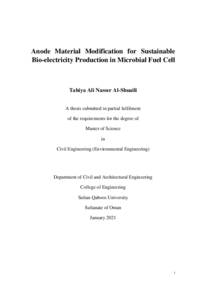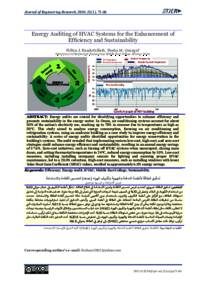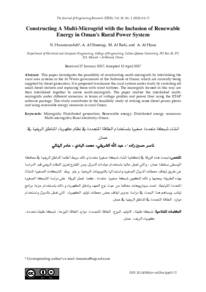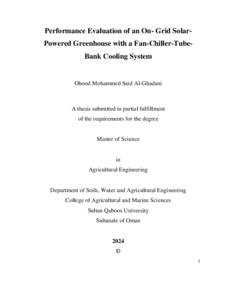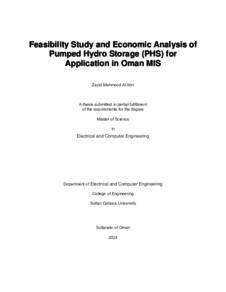Document
Anode material modification for sustainable bio-electricity production in microbial fuel cell.
Publisher
Sultan Qaboos University.
Gregorian
2021
Language
English
English abstract
In response to the increasing demand for clean water and energy due to the growing
global population and economic growth, it has led to an exponential search for
alternative renewable energy sources. The microbial fuel cell (MFC) is a promising
technology for energy production and wastewater treatment. It can recover bioelectric
energy from various types of wastewater. However, the cost and performance of the
anode material is closely related to the low power density and limited in its stability for
long-term application. Stainless steel mesh (SSM) is considered the preferred material
for microbial full cell (MFC) anode due to its excellent mechanical strength and low
cost, but its low biocompatibility and low corrosion resistance have limited its
application as an anode material. The composite material is very promising to improve
the configuration of the anode to enhance the performance of the MFC. In this study,
the reduced graphene oxide / polyaniline (rGO/PANI) composite is used to modify the
stainless-steel mesh. Due to its excellent mechanical and electrochemical properties
because of the strong 𝝿- bonded surface of the reduced graphene oxide and the 𝝿- 𝝿 in
interaction in the conjugated PANI. The composite material is prepared layer by layer.
First reduced graphene oxide is synthesized on the stainless-steel mesh surface by
electrodeposition method. It resulted not only the formation of a GO layer but also the
conversion of GO to a reduced graphene oxide (rGO). The polyaniline (PANI) was then
formed on the rGO surface via cyclic voltammetry electrodeposition like that of
graphene oxide. The present study is being conducted to investigate the structural
characteristics and electrochemical behaviour of the synthesised reduced graphene
oxide/polyaniline composite (rGO / PANI). The composite is prepared at different
graphene oxide mass concentrations to enhance electrochemical efficiency. The
scanning electron microscopy (SEM) Fourier Transform infrared (FTIR) and X-ray
diffraction (XRD) showed that the PANI nanofibers coated well on the surface of GO
and interposed into its layer. The electrochemical performance of the modified SSM
with rGO / PANI composite is analyzed by cyclic voltammetry (CV). The result was
that the rGO / PANI composite where the graphene concentration is 1.0 mg / mL
vi
displayed a higher current density (20.80 mA / cm2
) and an areal capacity of 42.9 (mF
/ cm2
) compared to the composites with lower concentration of graphene oxide. Also,
the composite produced good electrochemical performance compared to the SSM
fabricated with pure PANI and GO. These results are attributed to the large number of
active sites provided by a large surface area in graphene oxide for polyaniline
deposition and good synergic effect of GO and PANI. Therefore, these results highlight
the possibility of reduced graphene oxide / polyaniline composite as a cheap anode
material and good electrochemical performance that could have commercial
applications for the MFC system anode .
Member of
Resource URL
Arabic abstract
استجابة للطلب المتزايد على المياه النظيفة والطاقة نتيجة لتزايد عدد سكان العالم ، أدى التطور الاقتصادي إلى زيادة هائلة في البحث عن مصادر بديلة للطاقة المتجددة. خلية الوقود الميكروبية (MFC) هي تقنية واعدة لإنتاج الطاقة ومعالجة مياه الصرف الصحي. لديها إمكانية في استعادة الطاقة الحيوية من أنواع مختلفة من مياه الصرف الصحي. ومع ذلك ، فإن تكلفة وأداء مادة الأنود ترتبط ارتباطًا وثيقًا بكثافة الطاقة المنخفضة ويحد من ثباتها للتطبيق طويل المدى. تعتبر شبكة الفولاذ المقاوم للصدأ (SSM) مادة مرغوبة للأنود في الخلية الميكروبية الكاملة (MFC) نظرًا لقوتها الميكانيكية الممتازة وتكلفتها المنخفضة ، لكن التوافق الحيوي الضعيف ومقاومة التآكل المنخفضة حدت من تطبيقها كمواد الأنود. تعتبر المواد المركبة مادة واعدة لتحسين تكوين الأنود لتحسين أداء MFC. في هذه الدراسة ، تم استخدام مركب أكسيد الجرافين المختزل / بوليانيلين (/ rGOPANI) لتعديل شبكة الفولاذ المقاوم للصدأ. بسبب خواصه الميكانيكية والكهروكيميائية الممتازة بسبب السطح القوي المترابط لأكسيد الجرافين المنخفض والتفاعل ??-في PANI المترافق. يتم تحضير المركب بعد نهج طبقة تلو الأخرى. يتم تصنيع أول أكسيد الجرافين المختزل على سطح شبكة من الفولاذ المقاوم للصدأ بطريقة الترسيب الكهربائي. لم ينتج عنه تكوين طبقة GO فحسب ، بل أدى أيضًا إلى تحويل GO إلى GO (rGO) مخفض. ثم تشكل البوليانيلين (PANI) على سطح rGO عبر ترسيب كهربائي دوري لقياس الجهد الكهربائي مثل أكسيد الجرافين. تم إجراء الدراسة الحالية للتحقق من الخصائص الهيكلية والسلوك الكهروكيميائي لمركب أكسيد الجرافين / بوليانيلين المختزل (rGO / PANI). يتم تحضير المركب بتركيز كتلة مختلف لأكسيد الجرافين لتحسين الأداء الكهروكيميائي. أظهر الفحص المجهري الإلكتروني الماسح (SEM) تحويل فورييه للأشعة تحت الحمراء (FTIR) وحيود الأشعة السينية (XRD) أن الألياف النانوية PANI كانت مغلفة جيدًا بسطح GO وتم إقحامها في طبقتها. يتم تحليل الأداء الكهروكيميائي للـ SSM المعدل باستخدام مركب rGO / PANI عن طريق قياس الجهد الدوري (CV). نتج عن ذلك أن مركب rGO / PANI حيث تركيز الجرافين 1.0 مجم / مل أظهر كثافة تيار أعلى (20.80 مللي أمبير / سم 2) وسعة مساحية 42.9 (mF / سم 2) مقارنة بتركيز أكسيد الجرافين الأقل. أيضًا ، كان أداء المركب الناتج جيدًا في الكهروكيميائية مقارنةً بـ PANI النقي و GO المودعة في SSM. يتم تعيين هذه النتائج إلى العدد الكبير من المواقع النشطة التي توفرها مساحة السطح الكبيرة في أكسيد الجرافين لترسب البوليانيلين والتأثير التآزري الجيد لـ GO و PANI. لذلك ، تسلط هذه النتائج الضوء على إمكانية انخفاض مركب أكسيد الجرافين / بوليانيلين كمواد أنود رخيصة وأداء كهروكيميائي جيد يمكن أن يكون له تطبيقات تجارية لأنود نظام MFC
Category
Theses and Dissertations

